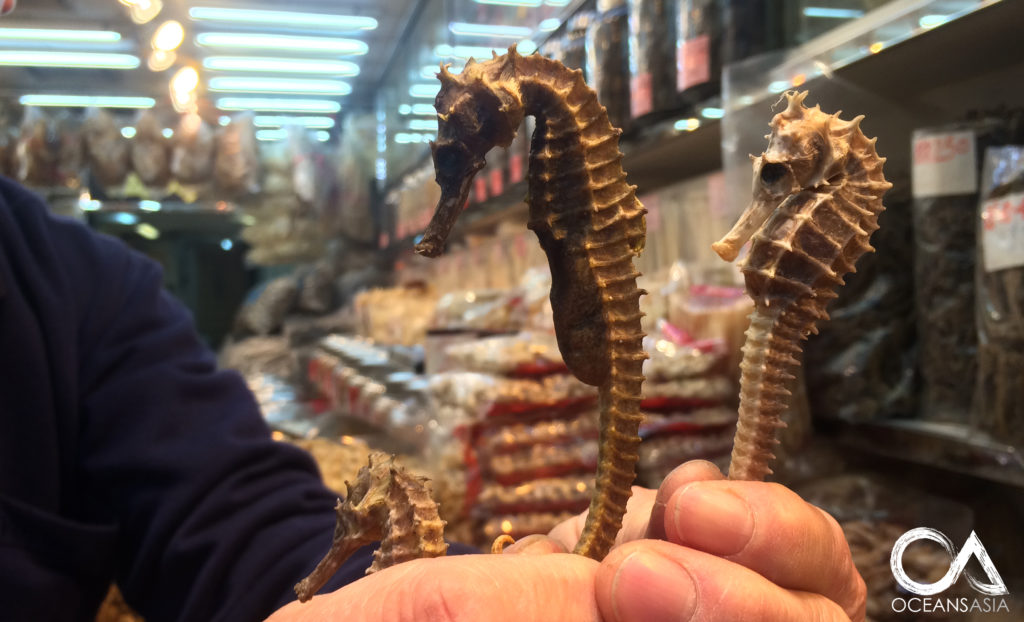CITES: Failing to Protect Seahorses

AUG 20, 2019
Today OceansAsia found a large shipment of pipefish drying in the streets of Hong Kong, whilst not illegal more than often we find their close relative seahorses drying openly and in plain sight as well. In Hong Kong the relevant authorities are the HK Customs who are clearly not discovering these large shipments likely due to the shipments being mis-declared to avoid detection. However once in Hong Kong the AFCD (Agricultural, Fisheries & Conservation Department) have the remit on all wildlife trade. With such large volumes so openly visible, why are the traders not being questioned about their source and permits being checked? The blame does not lie solely on Hong Kong’s authorities, the exporting countries have bans in place, yet they are clearly being fished and shipped without the local authorities checking.
Protection
With the CITES CoP19 currently underway in Geneva, one item up for discussion is Seahorses. Although they were amongst the first marine species to ever receive protection status back in 2002, OceansAsia regularly find massive shipments of seahorses along with pipefish drying in the streets of Hong Kong.
Background
The great majority of seahorses are obtained as bycatch in bottom trawls and other non-selective fishing methods. Such indiscriminate fishing obtains at least 37 million seahorses each year, a vast number that can easily enter trade. It is vital that such fisheries be constrained, even as trade is regulated. Most pipefish species are exploited for traditional medicines however some are sold in the aquarium tradeor as curios. Pipehorses of the genus Solegnathus are the most valuable syngnathids in Traditional Chinese Medicine.
Seahorses, pipehorses, and pipefish are harvested in range countries through directed fisheries and as bycatch. Bycatch currently accounts for the majority of specimens intended for the TCM and curiomarkets, whereas directed fisheries are usually the source of live specimens for the pet trade, as wellas a portion of the dried specimen trade. It is estimated that at least 20 million seahorses are captured annually from the wild. Bycatch of Syngnathids generally occurs in commercial fisheries directed at food fish orshrimp/prawns. The associated fishing methods are not conducive to the survival of individualsyngnathids with long net deployment times, abrasion, and compression. India, Indonesia, and the Philippines exhibit significant bycatch fisheries for seahorses, which are almost entirely destined forexport to the major importing TCM jurisdictions (China, Hong Kong, Taiwan). Although catch of seahorses per trip may be low, overall harvest by local fleets is significant. In terms of medicinal value, pipehorses rank above seahorses, which in turn outrank the smaller pipefish.

“Ongoing illegal, unregulated and unreported trade in dried seahorses
Despite the decline in reported exports of seahorses, there is evidence of illegal exports from at least some countries that have banned such exports. Fisheries surveys, trade surveys, or both in source countries with trade bans have revealed persistent illegal, unregulated and unreported (IUU) exports of dried seahorses, particularly from India, Malaysia, Philippines and Vietnam.
Media reports of seahorse seizures provide further evidence of illegal international trade.The most recent evidence for ongoing trade comes from 220 interviews conducted with traders in Hong Kong SAR, the largest entrepôt for dried seahorses, in 2016-17. In this study, traders reported obtaining dried seahorses from many countries with bans on seahorse exports, most notably Thailand and the Philippines – but also Indonesia, India, Malaysia and Vietnam. It was estimated that almost all dried seahorses in Hong Kong SAR (95%) had been imported from source countries despite export bans being in place, indicating a widespread lack of enforcement.
Importing and exporting Parties and national CITES Authorities clearly must take action to implement the Convention for seahorses. The Hong Kong SAR study’s findings identify failures in export and import control as well as a need to involve TCM and dried seafood traders as agents in generating compliance with trade bans. Given that export bans were implemented in response to concerns about the state of seahorse populations, ongoing illegal trade poses threats to the long-term future of the species.


Seahorses and pipefish are readily for sale online. A simple search on Facebook or Alibaba brings up many pages offering CITES listed seahorse species with the vendors whatsapp contact details, yet little action is being taken. The mere fact that a CITES Appendix 2 species can be ordered and shipped online across international borders from these online platforms shows how ineffective the CITES Appendices are currently being enforced.
Reference Sources: Project Seahorse, CITES, OCEANA

